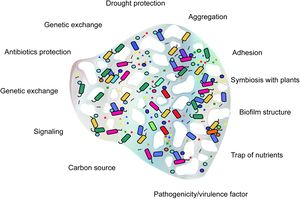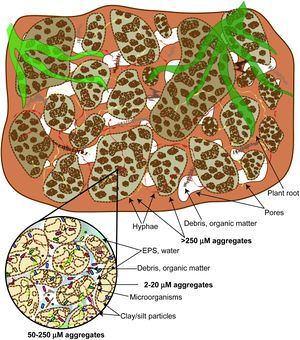Extracellular polymeric substance

Overview

Extracellular polymeric substances (EPS) are a group of substances exuded by microorganisms in order to form biofilms. The major components are extracellular polysaccharides (sometimes also called EPS), proteins, DNA, enzymes, lipids, and other biopolymers[1]. EPS accounts for 90% of biofilm dry mass and constitutes the matrix of the biofilm[1]. Biofilms are micro-habitats that keep microbes attached to a substrate[2], provide protection from desiccation[3,4], and play a key role in nutrient cycling[5]. Biofilms are also known to alter the structure [2,6], hydrology [4,7,8,11], and composition [6,9,10] of soils. EPS acts as an interface between soil and plants interactions with microbes. At the soil interface EPS facilitates chemical reactions and transportation of nutrients. At the plant interface EPS acts as the exchange media through which plant exudates and microbial secretions can be exchanged.
Functions

Habitat stability
The suspected primary role of EPS is to create stable habitat bound to a desired substrate[]. EPS is the matrix structure of biofilms. Biofilms are very effective at retaining water in soils even with very negative water potentials.[] This allows microbes to resist desiccation during drought periods. EPS can also stabilize pH and reduce the amount of nutrients lost to runoff by binding to them.
Chemical reactions
EPS provides a stable interface for soil microbes to chemically work on attached substrate and suspended materials. In addition EPS itself is a store of carbon and other nutrients. The binding nature of EPS also helps reduce nutrient loss in soils from runoff.[]
Hydrology
EPS resists evaporation by binding the water tightly[]. The biofilms formed with EPS can cause bioclogging of pores which resists evaporation and mass flow of water by reducing the hydraulic conductivity[]. This slows the rate of change in soil moisture content.
Soil Structures
EPS production fills soil pore space which reduces the effective average pore size[]. For the potential impacts of this see [porosity]. Also, the swelling shrinking actions of EPS water intake and loss can alter the pore space but there remains a lack of literature differentiating this effect in bulk soil[]. EPS plays a key role in soil aggregate formation by working as a cementing agent. This has the added effect of reducing soil slaking and increasing overall stability. This added stability can lower erosion rates and decrease nutrient runoff.
Plants
EPS holds microbes onto roots and acts as the medium for free living diazotrophs and other moderately symbiotic microbes to exchange nutrients in exchange for root exudates[]. There is also evidence to suggest EPS assists in salinity tolerance for some plants.[(Ashraf et al. 2004)]
Agriculture
There is growing interest in using EPS producing bacteria because they improve soil particle aggregation which improves agricultural soil health.[(Costa et al. 2018)]
Analysis methods
Cation exchange resin (CER) is currently considered the best method for accurately extracting EPS from soils.[(Redmile-Gordon et al. 2014)]
References
{{#invoke:Citation/CS1|citation |CitationClass=journal }}
[8]{{#invoke:Citation/CS1|citation |CitationClass=journal }}
[11]{{#invoke:Citation/CS1|citation |CitationClass=journal }}
{{#invoke:Citation/CS1|citation |CitationClass=journal }}
{{#invoke:Citation/CS1|citation |CitationClass=journal }}
{{#invoke:Citation/CS1|citation |CitationClass=journal }}
[3]{{#invoke:Citation/CS1|citation |CitationClass=journal }}
{{#invoke:Citation/CS1|citation |CitationClass=journal }} {{#invoke:Citation/CS1|citation |CitationClass=journal }}
[4]{{#invoke:Citation/CS1|citation |CitationClass=journal }}
[10]{{#invoke:Citation/CS1|citation |CitationClass=journal }}
{{#invoke:Citation/CS1|citation |CitationClass=journal }}
{{#invoke:Citation/CS1|citation |CitationClass=journal }}
[6]{{#invoke:Citation/CS1|citation |CitationClass=journal }}
[7]{{#invoke:Citation/CS1|citation |CitationClass=journal }}
{{#invoke:Citation/CS1|citation |CitationClass=journal }}
{{#invoke:Citation/CS1|citation |CitationClass=journal }}
[2]{{#invoke:Citation/CS1|citation |CitationClass=journal }}
{{#invoke:Citation/CS1|citation |CitationClass=journal }}
[1]{{#invoke:Citation/CS1|citation |CitationClass=journal }}
[5]{{#invoke:Citation/CS1|citation |CitationClass=journal }}
[9]{{#invoke:Citation/CS1|citation |CitationClass=journal }}
{{#invoke:Citation/CS1|citation |CitationClass=journal }}